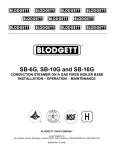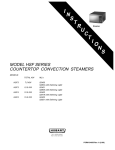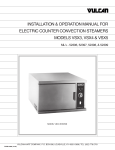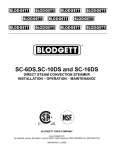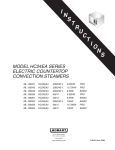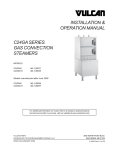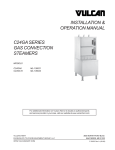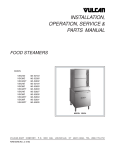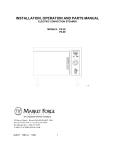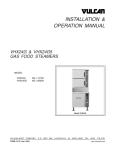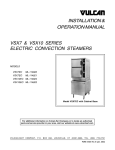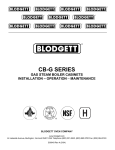Download Blodgett SB-10E Operating instructions
Transcript
SB-6E, SB-10E and SB-16E CONVECTION STEAMER ON AN ELECTRIC BOILER BASE INSTALLATION – OPERATION – MAINTENANCE BLODGETT OVEN COMPANY www.blodgett.com 44 Lakeside Avenue, Burlington, Vermont 05401 USA Telephone: (802) 658-6600 Fax: (802) 864-0183 1 D (7/13) S00047 Rev IMPORTANT NOTES FOR INSTALLATION AND OPERATION It is recommended that this manual be read thoroughly and that all instructions be followed carefully. This is the safety alert symbol. It is used to alert you to potential personal injury hazards. Obey all safety messages that follow this symbol to avoid possible injury or death. WARNING: Improper installation, operation, adjustment, alteration, service or maintenance can cause property damage, injury or death. Read the installation, operating and maintenance instructions thoroughly before installing, operating or servicing this equipment. CAUTION: Operating, testing, and servicing should only be performed by qualified personnel. NOTICE: Contact the factory, the factory representative or local service company to perform maintenance and repairs. Intended for commercial use only. Not for household use. This manual should be retained for future reference. 2 TABLE OF CONTENTS DESCRIPTION PAGE Important Notes .......................................................................................................... 2 1.0 Service Connections ............................................................................................ 4 2.0 Installation Instructions ........................................................................................ 5 3.0 Operating Instructions ......................................................................................... 6 4.0 Periodic Maintenance ......................................................................................... 10 5.0 Troubleshooting..................................................................................................... 14 6.0 Cooking Chart ....................................................................................................... 15 3 1.0 SERVICE CONNECTIONS ELECTRICAL CONNECTION: Rating to be as specified on data plate. COLD WATER: 3/8" O.D. tubing at 25-50 PSI (170-345 kPa) S STEAM TAKE-OFF CONNECTION: 3/4"IPS optional to operate adjacent equipment. DRAIN: 2" IPS piped to open floor drain. No Solid Connection. WATER QUALITY STATEMENT Water quality is the major factor affecting the performance of your appliance. If you are unsure of water quality, consult a local water treatment specialist and have the water analyzed. Your water supply must be within these general guidelines: Total dissolved solids Less than 60 PPM Total alkalinity Less than 20 PPM Silica Less than 13 PPM Chlorine Less than 1.5 PPM pH Factor 7.0-8.5 Water which fails to meet these standards should be treated by installation of water conditioner. FAILURE OR MALFUNCTION OF THIS APPLIANCE DUE TO POOR WATER QUALITY IS NOT COVERED UNDER WARRANTY. ELECTRICAL CHARACTERISTICS Available kW AMPS PER LINE MODEL STD. OPT. kW PHASE 208V 220V 240V 380V 415V 480V 600V SB-6E 24 36, 42, 48 24 3 66.6 63 57.8 36.5 33.4 28.9 23.1 SB-10E 36 42, 48 36 3 99.9 94.5 86.6 54.7 50.1 43.3 34.6 SB-16E 42 48 42 3 116.6 110.2 101 63.8 58.4 50.5 40.4 48 3 N/A 126 115.5 72.9 66.8 57.7 46.2 23 [584] 16.75 [425] 8.75 [222] 6 [152] 5.75 [146] 0 [0] 11.13 [283] 16.75 [425] 2.5 [64] 29.75 [756] 2.5 [64] SB-6E & SB-10E TOP VIEW SB-16E TOP VIEW REAR FLANGED FOOT DETAIL 2 EQUALLY SPACED Ø7/16" [11mm] HOLES ON 2.5 [63] B.C. 4 33 [838] 33 [838] 3.5 [89] 24.75 [629] 10 [254] 3.5 [89] 22 [559] 55.5 [1410] SB-6E 68.50 [1740] SB-10E 67 [1702] SB-16E 18 [457] 4.5 [114] 28 [711] S 36 [914] 24 [610] S 18 [457] (36" CABINET) S 8.75 [222] 2.75 [70] 27.5 [699] DIMENSIONS ARE IN INCHES [MM] 2.0 INSTALLATION INSTRUCTIONS Ideally an exhaust system should be located directly above the appliance to exhaust steam and heat generated by the appliance. 1. Set the unit in place and level using a spirit level. 2. Ascertain that a floor drain (open gap) is convenient to the appliance drain. 3. Mark hole locations on floor through anchoring holes provided in flanged adjustable feet. 4. Remove appliance and drill holes in locations marked on floor and insert proper anchoring devices. 5. Set unit back in position and re-level left to right and front to back. 6. Bolt and anchor appliance securely to the floor. 7. Seal bolts and flanged feet with Silastic or equivalent compound. 8. Make service connections as indicated. IMPORTANT: If your equipment was supplied with split water lines and a filter, connect the filter system to the connection marked “BOILER FEED” only. Make a second connection to the “CONDENSER FEED” from a cold and unfiltered water supply. WARNING: Electrical and grounding connections must comply with applicable portions of the National Electrical Code and/or other local electrical codes. WARNING: Disconnect electrical power supply and place a tag on the disconnect switch to indicate that you are working on the circuit. Use copper wire suitable for at least 200 degrees Fahrenheit (90 degrees Celsius). The steamer must be grounded. The wiring diagram is located on the inside right hand panel as you face the steamer. 5 3.0 OPERATING INSTRUCTIONS BOILER SECTION Electrically powered steam generators are available with standard boiler controls or ASME CSD-1 compliant controls. In addition to the ON/OFF power switch and indicator pilot light on the standard controls, the CSD-1 controls come with four more indicator pilot lights and a “Reset” switch. Follow the appropriate instructions for each. Start-up Procedure, Standard Controls 1. Turn on water and power supply to appliance. 2. Close the manual blowdown valve if the units is not equipped with the optional automatic blowdown valve. 3. Open door of cabinet and turn on Power Switch. Pilot light will come ON and water will begin to enter boiler. Once water level has reached the proper operating level as indicated on water gauge glass the heating elements will be energized and heat the water. When steam pressure has reached 11 psi the elements will de-energize and cycle on and off between 9 - 11 psi. The boiler is now ready for steam generation. Start-up Procedure, CSD-1 Controls 1. Turn on water and power supply to appliance. 2. Close the manual blowdown valve if the units is not equipped with the optional automatic blowdown valve. 3. Open cabinet door and turn "ON" power switch. The green pilot light will come "ON.” Water will begin to enter the boiler. When enough water has entered the boiler the (red) “Low Water” pilot will come on for approximately 10 seconds and then the (amber) pilot light will come. 4. Press the “Reset” switch to begin boiler operation. The “Standby” pilot light will go off and the boiler will begin operation. When steam pressure has reached 11 psi the elements will de-energize and cycle on and off between 9 - 11 psi. The boiler is now ready for steam generation. 6 3.0 OPERATING INSTRUCTIONS (Continued) Normal Boiler Operating Cycle Water Fill Cycle On the initial filling of the boiler, units equipped with CSD-1 controls require that the “Reset” switch be pressed to initialize the safety lockout circuit. Once the water in the boiler has reached proper level, the level control will stop the flow of water to the boiler. As water is consumed in the production of steam, the level control will supply and maintain safe water level in the boiler. Firing Cycle The elements are operated by pressure sensing devices. On initial operation, the boiler should reach 11 psi in approximately 15 minutes. At this point the operating pressure switch will open, de-energizing the elements. When the pressure drops to 9.0 psi, the pressure switch closes, energizing the elements. Condensing Drain, (Optional) A thermostat is located in the drain assembly and is activated by the temperature of steam. The thermostat operates the cooling solenoid, supplying water to the drain to condense the steam. Automatic Blowdown Valve, (Optional) If the unit has an automatic blowdown valve, it is activated when the main power switch is turned “ON”. The boiler will drain when the main power switch is turned "OFF.” Safety Lockout Conditions High Temperature Condition, Standard Controls A high temperature safety device is installed on the boiler. Should the temperature exceed the limit of this device, the boiler will be shut down. As the temperature returns to a safe level, normal boiler operation will resume. High Temperature Condition, CSD-1 Controls A high temperature safety device is installed on the boiler. Should the temperature exceed the limit of this device, the boiler will be shut down and switch to a state of lockout. The “Temperature” pilot light (red), and the “Standby” pilot (amber), will come on. 7 3.0 OPERATING INSTRUCTIONS (Continued) High Pressure Condition, CSD-1 Controls A high pressure safety switch is installed on the boiler. Should the pressure exceed the limit of this device, the boiler will be shut down and switch to a state of lockout. The “Pressure” pilot light (red), and the “Standby” pilot (amber), will come on. Should this device fail to operate, the safety relief valve will open. Low Water Condition, Standard Controls A low water safety cut off is supplied with the boiler. Should the water level fall below normal operating levels, the boiler will shut down. If the water level is returned to a safe level, normal boiler operation will resume. Low Water Condition, CSD-1 Controls A second low water safety cut off is supplied with the boiler. Should the water level fall below normal operating levels, the boiler will shut down and switch to a state of lockout. The “Low Water” pilot light (red), and the “Standby” pilot (amber) will come on. SHUT DOWN Turn off power switch, open manual drain valve. If unit is equipped with automatic blowdown valve, it will open and drain the boiler. 8 COOKER SECTION CAUTION: Live steam and accumulated hot water in the compartment may be released when the door is opened. Start-up procedures for your steamer must be completed once daily prior to operation (see instruction plate or above for boiler start up procedures). With ready pilot light on, preheat steamer compartment for one minute when the steamer is to be first used for the day or whenever the compartment is cold. 1. Close compartment doors and set timer to “1 minute”. 2. When buzzer sounds, set timer to the “OFF” position. 3. Steamer is now ready for cooking. 4. With cooking compartment preheated and ready pilot light on, place pans of food to be cooked into compartment and shut door. 5. Set timer to cooking time desired. Cooking cycle may be interrupted at any time by opening door and resumed again by closing door. 6. When buzzer sounds, it indicates the end of the cooking cycle and that no more steam is entering the compartment. Cooking pilot light will go off and ready pilot light will come on. Buzzer must be shut off by turning the timer to its off position. CAUTION: An obstructed drain can cause personal injury or property damage. Frequently check that the compartment drain and plumbing is free of all obstructions. Never place food containers, food or food portion bags in the cooking compartment in such a way that the compartment drain becomes obstructed. Each compartment is equipped with a removable drain screen. Frequently check the drain screen for accumulation of food particles. Should food particles accumulate against, or clog the drain screen, remove it, clean it thoroughly and then replace it in its original position. SHUT DOWN 1. To shut down cooking compartment, set timers to their OFF position and leave doors slightly open. 2. At the end of the day, the steam supply must be shut off. Open the door of cabinet base and turn off power switch. Open manual drain valve. If unit is equipped with automatic blowdown valve, it will open and drain the boiler. If unit is equipped with CSD-1 controls also refer to separate manual supplied with unit. 9 4.0 PERIODIC MAINTENANCE Never spray water into electric controls. NOTICE: Contact the factory, the factory representative or local service company to perform maintenance and repairs. Refer to warranty terms. Be sure to flush your boiler water level control daily. Failure to follow this procedure can cause the control to malfunction resulting in serious boiler damage. The Boiler Water Level Control installed on your boiler requires periodic maintenance. As boiler water circulates into the float chamber, sand, scale and other sediment may be deposited in the float chamber. While the chamber has been designed with a large accumulation bowl, it is necessary to flush the sediment from the chamber by blowing down the control so that the accumulation of sediment does not interfere with the movement of the float in the control. Control must be flushed at least once a day. CAUTION: Scald Hazard. Protect yourself. When flushing control, hot water and steam will flow out of the drain. CAUTION: Disconnect the power supply during cleaning or servicing. 10 CLEANING 1. Keep exposed cleanable areas of unit clean at all times. 2. Thoroughly wash oven cavities, door liners, and pan racks at the end of each day or as required with a mild detergent and water to prevent bacterial growth and odours. 3. Remove drain screens from inside compartment drains. Using a plastic bottle brush and mild detergent, clean inside the drain opening ensuring there is no food residue or blockage. Clean the drain screen and replace in its original position. 4. Wash gasket sealing surface with mild detergent to remove harmful food acids and rinse. 5. Water level control should be opened daily to blow down sediment and scalant. 6. Observe that the water in gauge glass is clean and clear. Extreme murkiness in water indicates inadequate water quality. 7. Safety valve should be tripped during operation once a week to assure that it functions properly. 8. Keep all exposed cleanable areas of unit clean at all times. DO NOT GET WATER IN ELECTRICAL BOX OR ANY ELECTRICAL COMPONENTS. CAUTION: Take extra caution when blowing down water level control or tripping safety valve as extreme hot water and live steam are present. 11 ADJUSTMENTS At least twice a year have an authorized service person clean and adjust the unit for maximum performance. DESCALING BOILER It is recommended that the boiler be checked every 90 to 120 days for scale build up. Regular maintenance should be carried out at this time. 1. With boiler empty, close manual blowdown valve. If appliance is equipped with Automatic Blowdown, turn water supply OFF to appliance. Turn power switch ON. This will energize and close the Blowdown valve. 2. Remove 3/4" pipe plug from fitting on left front of boiler. 3. Insert appropriate hose or tube through fitting and pour in (½) half gallon (U.S.) of CLR Descaling Solution or use the Optional Deliming Assembly DPA-1 available from your dealer. 4. Replace 3/4" pipe plug securely. 5. Open water supply to appliance allowing water to fill boiler to required level. 6. Let appliance cycle. Allow two hours for descaling and cleaning. DO NOT TURN ON STEAM to the compartments. 7. Open both the blowdown and low water level control valves for complete drainage and then close both valves. 8. Turn appliance switch ON. When boiler is completely filled turn power switch OFF. This will rinse and drain boiler. Appliance with manual Blowdown valve must be opened to drain. 9. Complete Step 8 twice to assure boiler is completely rinsed. 10. Appliance is now ready for use. 12 TO CALIBRATE PRESSURE SWITCHES NOTE: Pressure switches are factory set. Calibration is only required if pressure switches are replaced or if adjustment is required. Pressure switch range is from 1 to 15 psi. Adjust all settings to maximum on high signal adjustment screw. Adjust in the following sequence: - High limit pressure switch. - Override pressure switch. - Operating pressure switch. - Turning screw clockwise to increase, counterclockwise to decrease pressure. - Use relief valve to release pressure from boiler for setting adjustments. 1. HIGH LIMIT PRESSURE SWITCHES Allow pressure to build until unit shuts off. This should occur at 15 psi. Set the high signal to switch at 14.5 psi on the gauge and the low signal to 13.0 psi. 2. OVERRIDE PRESSURE SWITCHES Allow pressure to increase to 13 psi. Set the high signal to switch at 13 psi on the gauge and the low signal to 11 psi. 3. OPERATING PRESSURE SWITCHES Set the high signal to switch at 11 psi on the gauge and the low signal to 9 psi. 4. Release pressure in boiler to below 9 psi. Elements will come on. Once pressure has reached 11 psi, elements will shut off. Repeat this process several times to make sure elements come on at 9 psi and shut off at 11 psi. Once completed, pressure switches have been calibrated. Should your unit not have the High Limit pressure switch, start procedure at Override pressure switch. SERVICE Contact your local authorized service office for any repairs or adjustments needed on this equipment. 13 5.0 TROUBLESHOOTING DOOR LEAKS 1. Check for damage to door gasket. WATER ACCUMULATES IN THE COMPARTMENT 1. Compartment drain screen clogged. Remove and clean thoroughly and then replace. WATER NOT BEING SUPPLIED TO BOILER 1. Water supply is “OFF”. 2. Defective water fill solenoid. 3. Water level control clogged or defective, unable to operate fill valve. 4. Check drain valve is closed. Also check that water level control valve is closed. 5. Supply water pressure too low. AUTOMATIC BLOWDOWN VALVE DOES NOT DRAIN 1. Defective Blowdown valve. 2. Heat exchanger build up of scalant clogging drain lines and valve. BOILER ACHIEVES PRESSURE SLOWER THAN NORMAL a) Heavy build up of lime on elements. b) Loose element connections. SAFETY VALVE BLOWS 1. Defective safety valve. 2. Pressure too high. Pressure switch requires adjustment (lower) or may be defective. 14 6.0 COOKING CHART The following table lists suggested cooking times and weights. These times, which will vary depending on initial product temperature, size, shape, etc., are approximate and should be adjusted to suit your operation. PRODUCTS TO BE COOKED IN SOLID PANS Product Eggs, Scrambled Rice, Long Grain (Cover with 4 cups water/lb) Timer Setting in Minutes Weight Per Pan 10 - 12 8 Dozen 25 2 Lb Pasta (Place perforated pan inside solid pan, cover pasta with cold water) Spaghetti - Regular/Vermicelli 12 - 15 Macaroni - Shells/Elbows 15 - 18 Noodles - ½" Wide 12 - 15 Lasagna Noodles 15 - 18 Frozen Casseroles, Lasagna 35 Full Pan Meat Loaf, 3 - 5 Lb Each 40 15 Lb Ground Chuck 20 - 25 10 Lb Slices as Purchased 35 - 40 10 Lb 5 4 Lb Baked 9 10 Lb Can Refried 9 10 Lb Can 6 10 Lb Can Beef Shrimp, Frozen, 10 Shrimp per Lb Beans Canned Vegetables Prunes, Dried 12 - 15 15 PRODUCTS TO BE COOKED IN PERFORATED PANS Timer Setting in Minutes Weight Per Pan 10 - 12 3 Dozen 5-6 3 Dozen Claws 4 2 ½ Lb Legs 4-6 4 ½ Lb Lobster Tail, Frozen 6 10 Lb Lobster, Live, 10" - 12" 5 4 Per Pan Salmon Fillets, Frozen, 8 oz Each 5 7 ½ Lb Scallops, Fresh 4 3 Lb 3-5 4 Lb Hard Cooked 15 4 Dozen Soft Cooked 9 - 10 4 Dozen Soft Yolk for Caesar Salad 6-8 4 Dozen 20 15 Lb Breasts (2) 90 6 - 7 Lb Ea. Cut length wise 55 20 - 25 Lb 40 - 75 6 - 8 Lb 3 80 - 100 Count Frozen 10 - 12 3 Dozen Fresh 5 5 Lb Green, 2" Cut, Frozen/Fresh 6 5 Lb Lima, Frozen 8 5 Lb Baby Lima, Frozen 5 5 Lb Spears, Frozen 8 4 Lb Spears, Fresh 6 5 Lb Flowerettes, Frozen 6 5 Lb Product Clams Frozen Fresh, Cherrystone King Crab, Frozen Scrod Fillets, Fresh Eggs Chicken, Breasts, Legs, Thighs Turkey, Frozen Corned Beef Hot Dogs or Wieners Asparagus Spears Beans Broccoli 16 PRODUCTS TO BE COOKED IN PERFORATED PANS Timer Setting in Minutes Weight Per Pan Brussel Sprouts, Frozen 6 5 Lb Cabbage, Fresh, 1/6 Cut 8 5 Lb Baby Whole, Frozen 8 7 Lb Crinkle Cut, Frozen 7-8 4 Lb 11 9 Lb Frozen 6 4 Lb Fresh 7-8 5 Lb 7 5 Lb Yellow Whole Kernel, Frozen 5 5 Lb Cobbettes, Frozen 8 27 Ears 16-18 80 Ears 10-12 18 Ears 16-18 54 Ears Peas, Green 6 5 Lb Potatoes, Whole Russet 55 10 Lb Chopped, Frozen 17 6 Lb Defrosted 5 6 Lb Fresh Cut 3 2 Lb Squash, Acorn, Halves 25 10 Halves Zucchini, Slices 8 10 Lb 6-7 5 Lb Product Carrots Sliced, Fresh Cauliflower, Flowerettes Celery, 1" Diagonal Cut Corn Corn-On-Cob, Fresh Spinach Frozen Mixed Vegetables Fruit, Blanch for Peeling 3 Grapefruit Oranges Pineapple, Whole for Cutting 4 COOKING HINTS Where possible, spread food out evenly in pans. Do not allow food to protrude above pans, since this will interfere with steam circulation between pans in the compartment. Always preheat compartments for satisfactory results. When time does not allow for defrosting of frozen vegetables, such as loose-pack peas, corn diced carrots, etc., they may be cooked at once provided just half of the suggested portions in the cooking chart are used. 17


















